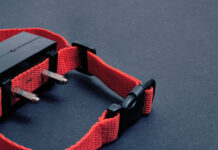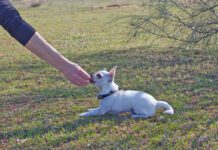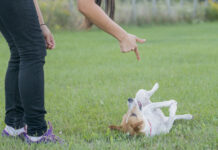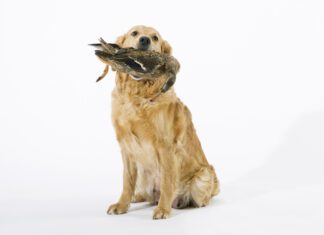The transition from on-leash training to off-leash reliability can be a frustrating challenge. “But he knows what ‘come’ means!” a client wails, and points as proof to the fact her dog comes impeccably, every time, when called in the training center, the house, or the backyard.
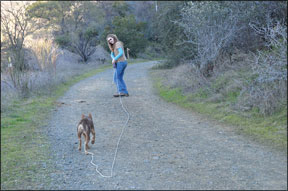
Her dog does know what come means – in the training center, in the house, and in the backyard. He also knows that when he’s hiking in the woods, chasing squirrels and rabbits is far more rewarding than coming back when he is called, especially since “Come” often means “The hike is over, the leash is going on the collar, and we’re returning to the car.”
A long line is a valuable tool that can help you navigate the transition from “Coming reliably when called within a safe, controlled area” to that pinnacle of dog training: “Coming reliably when called regardless of where we are or what other exciting things are happening.”
The purpose of the long line is simply to restrain your dog so he can’t be reinforced by tearing after Bambi in the woods. It’s up to you to make yourself interesting and exciting enough to get him to return to you. The long line is not for yanking or dragging him back to you; that will only serve to confirm his opinion that playing in the woods is more fun than hanging out with you!
Here’s the right way to use a long line as a training tool:
–Train a wildly enthusiastic “come” response in controlled environments. Practice with a long line in controlled circumstances as well as doing off-leash recalls, so the long line becomes part of the recall fun.
–Use enclosed areas of different sizes to practice with your dog on and off of the long line. Find a friend with a securely fenced pasture of an acre or more or go to a fenced community dog park during low-usage times when your dog won’t be distracted by other dogs, so you can do your off-line work without worrying that he will disappear into the National Forest for days at a time.
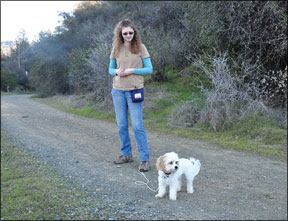
Note: If you plan to drop your long line and let the dog run with it attached to his collar, be sure you are not training anywhere where he might vanish into the woods and become inextricably tangled around trees and brush.
–Whenever you arrive at a new location, do five or ten minutes of enthusiastic recall practice on the long line, interspersed with other good manners training, before removing his leash. Then do a few minutes of focused off-leash training. This will teach him that training happens even in exciting places – a trip to his favorite park does not mean immediate and total lack of control, and removing the leash is not an invitation to charge off into the brush.
–When you first let your dog off the leash, do some short recalls and make them very rewarding and fun – deliver his absolute favorite treat that he only gets when he comes when called, or a quick game of tug with a toy or fetch with a ball that he obsesses over.
–As you hike the enclosed area with your dog, look for opportunities to call him when he’s very likely to come: when he’s looking a bit bored, not when he’s fixated on a squirrel up a tree or totally preoccupied digging a hole. When he comes, make wonderful things happen, then let him go play again. This teaches him that “come” means “wonderful yummy fun-stuff break and then go play,” not “fun’s over, time to go home!”
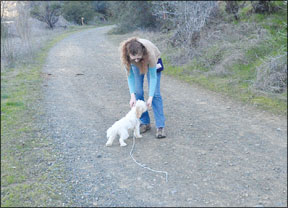
–Occasionally during the outing, put the long line back on his collar, hold it, and walk with him no more than 10 feet away from you on the line (this works in better in open pasture than in heavy woods and brush). When one of you spots a squirrel or a rabbit, call him to you. When he comes, tell him what a wonderful dog he is, have him sit, feed him a treat if he’s interested, then release the line, and say “Go chase!” Run toward the squirrel with him to encourage him, if he needs it.
If he doesn’t come, don’t get angry and don’t drag him back to you with the long line. Just wait, holding the line, until he realizes he can’t get to the squirrel and returns to you.
This is the “Premack Principle” which says that the way to get something really wonderful is to do something less wonderful first. In this case, the road to “squirrel” is through “come to me.” As he gets better and better at responding, let him range farther and farther, dragging the long line until, he will “Premack” back to you from 50 feet or more in order to earn his squirrel chase. (Premack also gives the squirrel a significant head start to the nearest tree.)
When your dog returns reliably from the distant reaches of the long line even in the face of thundering herds of squirrels and rabbits, start Premack off-leash. Do your first off-leash test when your dog is near you. When he sees a squirrel at a distance call him, reward with his favorite reinforcer, have him sit, and then tell him to “Go chase!”
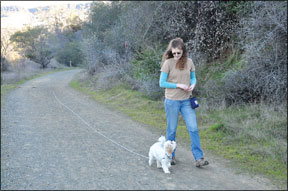
If he takes off after the squirrel instead of coming, don’t keep calling. Wait until he tires of the squirrel, then call him back to you in a pleasant tone, and go back to practicing on the long line. Do not punish him!
The reliable recall, trained with the help of a long line, can serve you well in a variety of challenging circumstances. The temptation can be other dogs playing, an invitingly cool pond on a hot day, or a steaming-fresh pile of horse manure. You could be the dog owner who can proudly say, “My dog knows what ‘Come’ means – everywhere, every time!”


